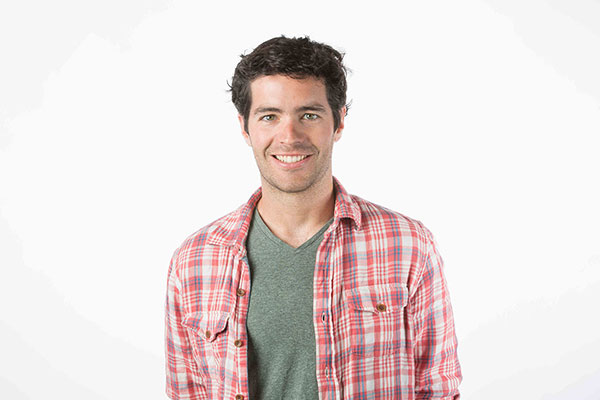WHAT ARE THE DIFFERENCES BETWEEN ROAD AND MOUNTAIN BIKING WHEN IT COMES TO BIOMECHANICS, GEAR, AND TRAINING?
By  Dan Feeney
Dan Feeney  Kate harrison
Kate harrison
Follow on ![]()

Quick Takes
- Mountain biking demands the ability to generate high power outputs for short bursts interspersed with technically challenging sections that will stress the mind and the body.
- Position on the bike and technical demands vary between courses, which allows riders to focus on different skills and avoid overuse injury and boredom.
- We expect more biomechanical research on mountain biking in the coming years with better technology that can be used in the field.

Dan’s Take
I was an avid road cyclist for years while racing as a pro triathlete on the International Triathlon Union circuit. My first mountain bike experience was on a late 1980s Schwinn model without much suspension; not surprisingly, I finished the ride a bit frustrated and bloody but wondering how I could ride so well on the roads yet be such a novice on the trails. Fast forward 10 years and I have a full suspension bike with clip-in pedals and love exploring new trails on my mountain bike. Gear, adequate technical skills, and a proper mountain bike fit are crucial to dialing in to enjoy the trails.

Kate’s Take
As a commuter cyclist who may occasionally dabble in road cycling, mountain biking has been something of a mystery to me. As I watch mountain bikers shoot past me while I run and hike up and down steep technical terrain, I’m impressed, to say the least. Through co-workers at BOA – I’ve learned more about the engineering, training, and healthy dose of fearlessness that makes this sport possible. The biomechanical research on mountain biking is in its infancy, only just catching up to the knowledge of experienced riders – but I look forward to seeing how both the tools and training can be enhanced with the help of science to bring these athletes to new levels.

BOA’s Take
Born in the mountains, we are inspired every day by athletes pushing their limits through rock gardens, technical singletrack, and days with 10K feet of elevation gain. Sending big drops, crushing steep climbs, and charging downhill demands footwear that can keep up. We offer riders the ability to make single-handed micro-adjustments on the fly. With a dialed-in fit, they can keep their focus on the course, and not on their shoes.
.jpg)
Research on the Topic
Our first cycling article covered a plethora of biomechanics research but primarily focused on road riding as there is much more literature available. Most scientific research in mountain biking focuses on injury prevention, but given the recent increase in mountain bike participation, we expect the study of the biomechanics of mountain biking to vastly expand in the coming years. Both road and mountain biking demand a high degree of fitness, a proper bike fit, and great technical prowess to both prevent injury and enjoy your ride. From a physiological standpoint, mountain biking is quite like trail running. On the trails, athletes alternate between bouts of high-power output with periods of high technical demand. Mountain biking requires a strong fitness foundation but – like trail running – the technical sections of races separate high-level racers more than the smooth, high-power sections. Based on these differences, your training and gear need to reflect your course and goals.
PHYSIOLOGICAL DIFFERENCES
The largest difference between training for mountain vs road biking comes in the variability in power and cadence required to be successful. While average power in a road and a mountain bike race may be similar, normalized power will often be higher on a mountain bike, meaning you have more high-intensity spikes in power. One can produce high power from a combination of force and cadence and most riders identify along the spectrum from ‘grinder’ (low cadence/high force) to ‘spinner’ (high cadence/low force). Cycling with a high cadence puts more stress on your cardiovascular system, while a low cadence coupled with a high force is more difficult muscularly. A strong rider needs to be comfortable at a range of cadences (usually from 60-120 rpm), but mountain biking often requires you to move through that range more frequently than on the roads. As a result, mountain biking performance is best predicted by an athlete’s anaerobic threshold in combination with their performance on an all-out 1 min sprint. In fact, more than 80% of mountain bike races lasting around 2 hours are spent above an athlete’s lactate threshold (closely tied to anaerobic threshold), which most riders recognize as the intensity where you start to feel extreme effort (burning muscles or the taste of blood in the back of your mouth).
Finding the right cadence to produce high power is critical and differs between the skill and physiology of riders. While many people tune in to the Tour de France and watch professional riders churn out 400+ watts at 115 revolutions per minute, this isn’t the best strategy for most amateur riders, who have less efficient pedal strokes. Regardless of riding on the road or on the trails, most serious- but non-professional- riders should find a tempo that feels natural to them, which will optimize power output and efficiency. With increased time in the saddle and a focus on tempo, riders can improve their range of comfortable cadences.
Riders should train by intentionally including both high and low cadence efforts to ensure they can make it over technical terrain or cover a surge at any stage of a road race or group ride but fall into their preferred cadence for steady-state riding. A great workout for riders to work on cadence is 10 x (1 minute at 120 RPM and 1 minute at 60 RPM) near your critical power. Once you have mastered riding at this power with different tempos, you can progress to a higher power while focusing on not bouncing during the high cadences and being strong enough at the low cadences.

Shawn Neer rides in the Giro Ventana MTB Shoe.
BIOMECHANICS AND TECHNICAL SKILLS
Fit is critical to be technically adept on the road and on the trails, but mountain biking requires more extreme maneuvers to navigate the terrain than typical road courses. These extreme maneuvers dictate your fit and gear. While the kinematics of mountain biking have not been described in scientific literature, we can glean some obvious differences based on bike geometry. The geometry of mountain bikes, along with aerodynamics being less important on the trails, define a more upright position. Bike to body fit and geometry substantially affect where cyclists tend to experience any discomfort or injury – potentially reducing back issues.
Aside from baseline bike position, movement while on the bike differs between road and trail riding. There are three primary areas of contact on a bike: handlebars, saddle, and pedals. Riders use all three on the road unless climbing or supertucked, while mountain bikers spend a lot more time out of the saddle. In order to navigate technical and steep descents, mountain bikers are typically standing up and shifting their body mass towards the rear of the bike. This helps prevent the undesirable, embarrassing, and dangerous result of going over the bars (OTB). Research on the biomechanics of riding out of the saddle have focused on uphill riding (for example, Tang et al. 2020, and Berkemeier 2020). Downhill riding while out of the saddle requires the posterior leg muscles (hamstrings, glutes) to support more body weight and stabilize the body side to side, which is a feeling most road cyclists will be unaccustomed to on their first mountain bike ride.
Scientifically evaluating mountain biking on technical terrain to date has been limited for a couple of reasons: 1) constraints of laboratory tools (no labs that we know of have MTB trails built inside, yet!), and 2) the liability of asking research participants to perform rides with inherent injury risk. That said, the world of biomechanics is beginning to evaluate extreme maneuvers. Tools such as force-measuring insoles and inertial measurement units are allowing more accurate assessment of biomechanics in an athletes’ typical training and competition environment. This basic science – quantifying forces, accelerations, and timing of jumping – is critical to better understand the mechanical demands of technical maneuvers. Another extreme sport, ski jumping, was similarly under-studied, but after being adopted as an Olympic sport, the science caught up in order to understand and optimize these movements for athletes. We expect mountain biking will move in this direction over the next decade.

WHAT YOU NEED IN A SHOE (CLIMBING, DESCENDING, CLIP-IN SHOES)
Because you will be out of the saddle during a large portion of mountain bike rides, you will rely heavily on the other two points of contact: your hands and feet, meaning these two areas are even more important than in a road bike setup. Cycling shoes keep you firmly planted on the midsole so you can exert high forces onto the pedals; however, there are a few other considerations when selecting the best shoe for your riding style. Cross-country riders often prefer clip-in shoes so they can generate a smooth power output throughout the pedal stroke. Meanwhile, many downhill-specific riders choose flat pedals for easier pivoting and ease of dismounting. Despite what cycling lore may suggest, pulling up on the pedals – which clip-in pedals should help you do – does not substantially improve cycling performance; nevertheless, most riders feel stronger and more confident when clipped in while climbing a steep hill. Lastly, you will see a variety of outsole options in mountain bike shoes. A cross-country race shoe will most likely have a carbon outsole with minimal grip, while a trail shoe designed for rides that include a hike-a-bike will have a grippier, more durable outsole.
The fit of your shoes is critical since the direction and magnitude of force applied to the pedal will be highly variable. These conditions have the potential to magnify any hotspots that may inhibit your power output over a long ride. This is a key area that we are investigating in our lab.

Five Ten Kestrel Pro BOA MTB Shoe
How we test
We recognize the importance of micro-adjustability in holding the foot firmly onto the sole of the shoe during extremely powerful pedal strokes, while not creating any pressure points that can lead to numbness. Further, as the foot changes shape due to changes in blood flow and heat during high-intensity activity, the ability to alter the fit of the shoe over a long ride is highly valued by cyclists, and something we are working to quantify and optimize.
In the lab, we ask cyclists to ride at 70-75% of their maximal heart rate (corresponding with a Zone 2-3 effort for most riders) for 1 hour with a variety of short sprints throughout the ride. During these sprints, we measure the pressure distribution across the top and bottom of the foot within the shoe, as well as power output, and energetic expenditure with a metabolic cart, and heart rate. Preliminary data in our lab indicates that greater area of foot contact with the sole- providing more even distribution of pressure- during a high-power effort is advantageous for riders and is indicative of superior fit.
For athletes, coaches, and retailers
Riders should optimize fitness, bike fit, and technical skills to enjoy their time on the trails. Many riders enjoy mixing it up between roads, trails, gravel etc., to build new skills, avoid overuse injury, and keep things interesting. Riders should work with their local bike shop to obtain the right geometric fit that is specific to the type of riding that they are doing. Moreover, shops can help you find the right bike for your desired riding style: if you primarily rip downhill trails, you will want a vastly different bike than that used for road racing or cross-country mountain biking. Shops can help you find local trails or roads that are great for your skill level too.
We can be found in twitter .@Dfeeney31 and .@running_geek